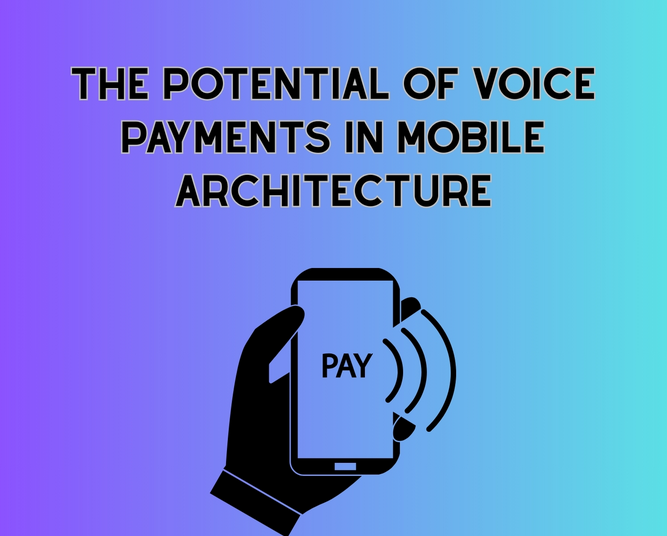The Potential of Voice Payments in Mobile Architecture

The world of mobile payments is evolving rapidly, with technology constantly pushing the boundaries of how we interact with digital services. Among the most exciting innovations is the rise of voice payments, which enable users to make transactions through voice commands. As mobile architecture becomes more advanced, integrating voice payment systems offers users new opportunities for making secure, seamless, and hands-free transactions. Let’s explore the potential of voice payments in mobile architecture and how they are reshaping the future of payments.
1. Seamless, Hands-Free Transactions
Voice payments utilize voice recognition technology, enabling users to complete transactions simply by speaking to their mobile devices. This hands-free convenience can make purchasing products, paying bills, or transferring money as easy as asking your smartphone to do it. Whether you’re driving, cooking, or multitasking, voice payments allow users to execute payments without having to touch or even look at their device, offering a level of convenience that traditional mobile payment methods can’t match.
Why it matters:
- Convenience: Voice payments simplify transactions, allowing users to make payments while performing other tasks.
- Increased accessibility: For users with physical disabilities or those who struggle with typing, voice payments offer a more accessible way to engage in mobile transactions.
2. Enhanced Security Features
Voice payments offer an extra layer of security through voice biometrics, a form of voice authentication that analyzes unique vocal characteristics. Unlike passwords or PINs, voice biometrics is incredibly difficult to replicate, providing a high level of security for transactions. Users’ voiceprints are unique, just like their fingerprints, which makes them more secure than traditional payment methods. Voice authentication, when paired with other security measures like two-factor authentication (2FA), can further protect mobile transactions.
Why it matters:
- Secure transactions: Voice biometrics ensures that transactions are authenticated in a safe, user-friendly manner.
- Convenience: Voice recognition adds security without requiring users to memorize or enter complex passwords.
3. Integration with Smart Devices and IoT
Voice payments fit seamlessly into the expanding Internet of Things (IoT) world. Many consumers now use smart speakers, such as Amazon Alexa or Google Assistant, to control their homes, access information, and even make purchases. Integrating voice payment systems into mobile architecture allows users to make payments using these smart devices. For instance, you could order food or buy a product from a website, simply by instructing your voice assistant to make the purchase.
Why it matters:
- Interconnected ecosystem: Voice payments can work across multiple devices, creating a seamless shopping and payment experience.
- Simplified transactions: Integrating voice payments into smart devices provides users with the flexibility to conduct transactions across their connected ecosystem.
4. Expanding Accessibility and User Experience
Voice payments are especially beneficial for improving user experience in environments where using a screen or touch interface might be inconvenient, such as while driving, walking, or engaging in physical activities. In addition, voice payment systems could significantly enhance the inclusivity of mobile payments by allowing older adults and people with disabilities to make payments without relying on physical interaction with their devices.
Why it matters:
- Inclusive technology: Voice payments create a more accessible environment for people who may struggle with traditional mobile payment methods.
- Ease of use: Voice commands are more intuitive for many users, resulting in a better overall user experience.
5. Challenges to Overcome
While the potential of voice payments is exciting, there are challenges to address. The accuracy of voice recognition systems needs to be improved to ensure seamless interactions, particularly in noisy environments. Additionally, privacy concerns surrounding the collection of voice data must be carefully managed, with transparent policies and robust encryption to protect users’ personal information.
Why it matters:
- Reliability: Ensuring the accuracy of voice commands is crucial for creating trust in voice payments.
- Privacy concerns: Proper data management and transparency are essential to avoid security risks.
Conclusion
Voice payments hold significant potential in mobile architecture, offering hands-free convenience, enhanced security, and seamless integration with Internet of Things (IoT) devices. While there are challenges to address, such as accuracy and privacy, the future of voice payments looks promising. As technology continues to evolve, voice payments could become a key player in mobile transactions, making the way we pay more efficient, secure, and accessible.
#VoicePayments #MobilePayments #MobileArchitecture #VoiceRecognition #SmartDevices #IoT #PaymentInnovation #UserExperience #DigitalPayments #FutureOfPayments

